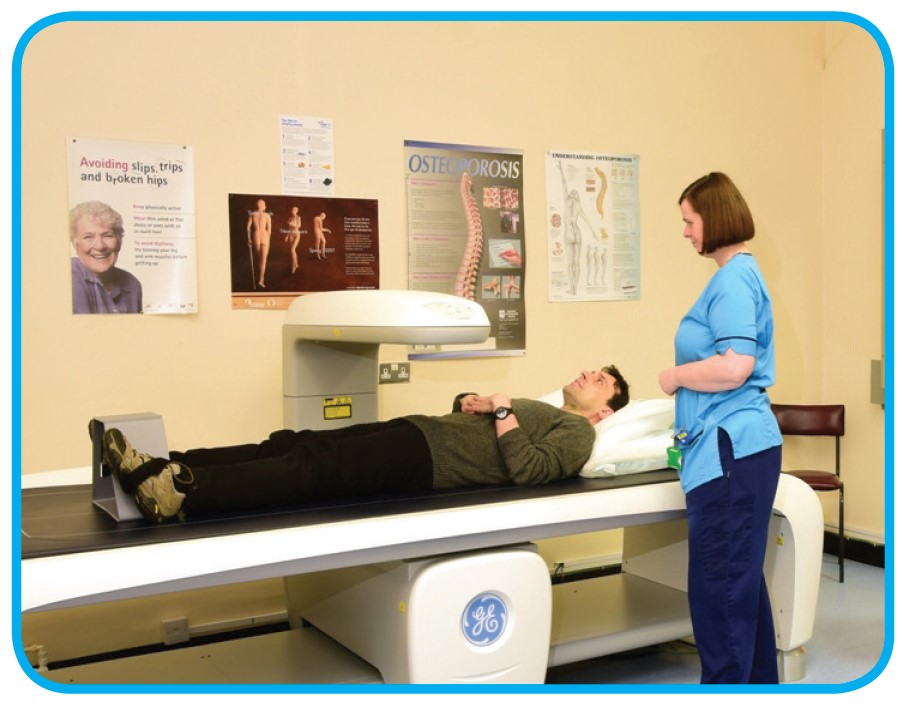Osteoporosis
On this page
The Fracture Liaison Service (FLS) systematically identifies people aged 50 and older, who have had a fragility fracture (break).

About the Fracture Liaison Service
Certain fractures may be because of thin or porous bones - osteoporosis - and identifying this may allow treatment with the aim of reducing further risk of fracture.
Osteoporosis can be identified by a simple X-ray technique called a DXA scan which only takes a few minutes to perform. Through practical advice and support we explain lifestyle changes that make a real difference, which can include:
- increasing exercise
- reducing alcohol intake
- improving nutrition for adequate intake of calcium
- stopping smoking
- recommending supplemental Vitamin D and medication
NHS Highland introduced its first Fracture Liaison Service in 2004, as an integral part of the Highlands Osteoporosis Service.

DXA scanning
The DXA (or DEXA) scanning service for the Highland area is based at the Ross Memorial Hospital in Dingwall. The service has one DXA scanner which is housed in a large and comfortable room. There are changing cubicles available in the X-ray department for patients to change if required. Leaflets are readily available for all patients.
Patients aged 50 years and older who have sustained a fragility fracture (other than skull, fingers and toes) can be referred for a DXA scan.
Patients aged 75 years and older who have suffered a fracture can be recommended to go straight onto treatment without the prior need of a DXA scan. A letter detailing treatment recommendations will be sent to the patient's GP.
Patients who have not suffered a fracture may also be referred by their GP or hospital consultant for a DXA scan, when they may be at an increased risk of developing osteoporosis.
DXA team
The DXA team comprises:
- a highly experienced lead DXA reporting radiographer
- a specialist trained radiographer
- an osteoporosis specialist GP
- an FLS co-ordinator
- an osteoporosis secretary

Calcium, vitamin D and exercise
Calcium
Calcium gives your bones the strength and hardness they need to cope with your everyday activities. Most adults need 700mg of calcium a day. Try this calcium calculator to help you find out if you are having enough calcium in your diet.
Vitamin D
Vitamin D is vital to absorb calcium and help your bones, muscles and teeth to remain strong. You can get vitamin D through sunlight, diet and supplements. Try this Vitamin D-rich food chooser to find foods rich in vitamin D, and calculate how much you're getting each day.
However, it is difficult to get enough vitamin D from food alone. The majority of vitamin D we need will come from sunlight exposure. In Scotland, your skin can only make vitamin D from sunlight between the beginning of May and the end of September. Everyone should therefore consider taking a daily supplement. Most adults in Scotland will need 800 IU of vitamin D a day.
Exercise
Physical activity is very important for our bone health and to decrease our chance of falling and breaking a bone. We encourage everyone to be physically active within their own capabilities. Visit High Life Highland for local information about gyms and exercise classes.
Help from The Royal Osteoporosis Society
The Royal Osteoporosis Society has developed information on managing bone health and all other aspects of osteoporosis, including:
- nutrition
- medication
- exercise
Free osteoporosis helpline
Anyone can contact their free helpline for tailored information and support about osteoporosis and bone health:
- phone 0808 800 0035
free from UK landlines and mobiles
available Monday to Friday, between 9am and 12.30pm and between 1.30pm and 5.00pm - email nurses@theros.org.uk
You do not need to be a member of the charity to use this service, which is provided by nurses with specialist knowledge of osteoporosis and bone health. The team is supported by a group of scientific and medical advisers, to ensure the information they give is accurate, independent and up-to-date.
Callers who are hard of hearing can use Typetalk. A translation service is provided for calls. Nurses aim to answer email queries within ten working days.
Related information
See also:
- Chronic pain management
- Falls prevention
- Fracture Risk Assessment - Royal Osteoporosis Society
- Fracture Risk Assessment Tool - University of Sheffield
- Causes of osteoporosis - Royal Osteoporosis Society
- #BoneMatters online information events - Royal Osteoporosis Society
In-person services and locations
Other services
Your Services
-
Know who to turn to
Know how to get the right care, in the right place.
-
In-person services and locations
Lists and exact locations of hospitals, A&E departments, care homes, GP and dental practices, sexual health clinics, ...
-
Near Me
NHS Highland offers Near Me video appointments.
-
Access to services
Accessibility, and ways to help you access your services. Related services for patients and public.
